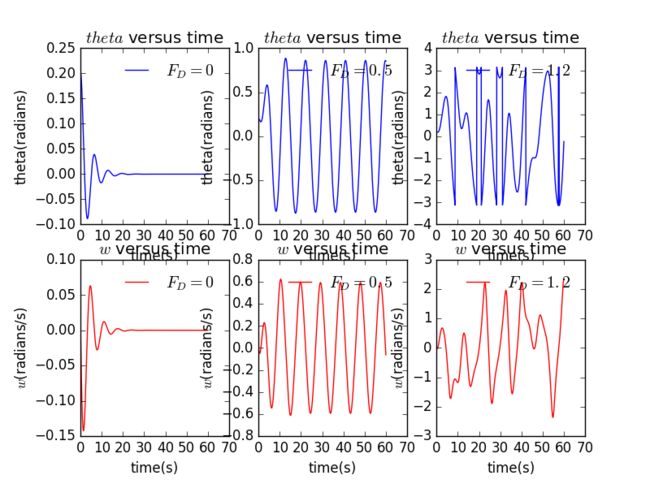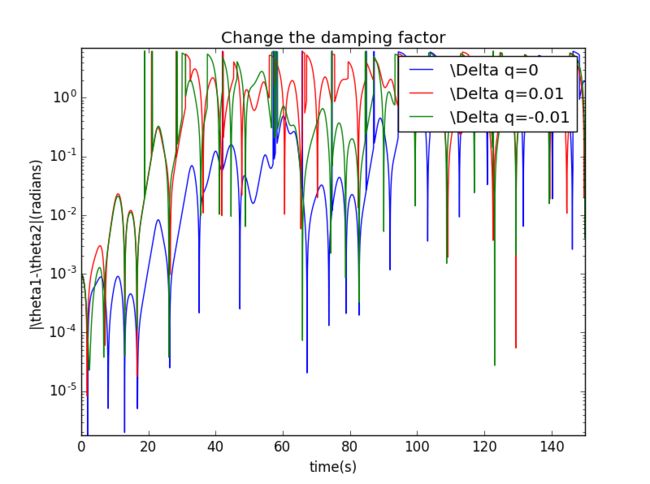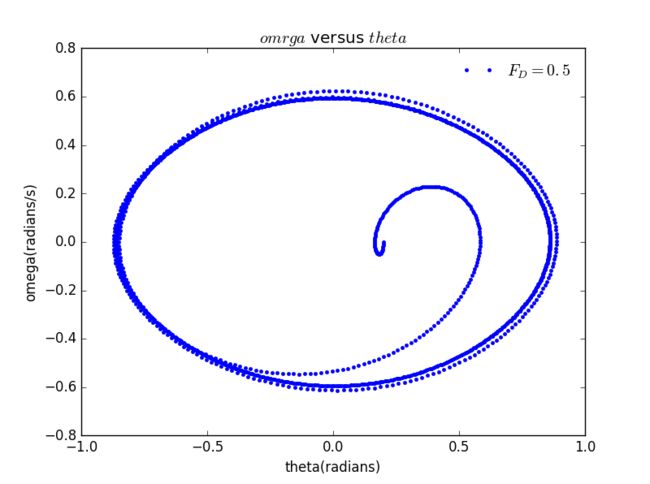1.Abstract
Oscillatory phenomena can be found in many areas of physics, including the motion of electrons in atoms, the behavior of currents and voltages in electronic circuits, and planetary orbits. But the simplist one may be the motion of pendulums. Through analying this simple example, we will have a better understanding of oscillatory motion and chaos. Chaos theory is the field of study in mathematics that studies the behavior of dynamical systems that are highly sensitive to initial conditions. Small differences in initial conditions yield widely diverging outcomes for such dynamical sysytems, rendering long-term prediction impossible in general. In this homework, I will mainly talk about effects of initial conditions to chaos and some points about strange attractors.
Question3.12 and 3.13
3.12. In constructing the Poincare section in Figure 3.9 we plotted points only at times that were in the phase with the drive force; that is, at times
where n is an integer. At these values of t the driving force passed through zero [see(3.18)]. However, we could just as easily have chosen to make the plot at times corresponding to a maximum of the drive force, or at times \pi/4 out-of-phase with this force, etc. Construct the Poincare sections for these cases and compare them with Figure 3.9.
3.13. Write a program to calculate and compare the behavior of two, nearly identical pendulums. Use it to calculate the divergence of two nearby trajectories in the chaotic regime, as in Figure 3.7, and make a qualitative estimate of the corresponding Lyapunov exponent from the slope of a plot of log(\Delta\theta) as a function of t.
3.14. Repeat the previous problem, but give the two pendulums slightly different dampling factors. How does the value of the Lyapunov exponent compare with that found in Figure 3.7.
2.Background and Introduction
Before our this class, we have already learned some basic knowledge about the single pendulum, without damping and driving force, and when tilt angle is very small, the motion function of the pendulum can be written as
Obviously, the pendulum will do a periodic motion.
If we add damping to our pendulum, the motion function will become
And it will give us some interesting results. But, we can easily tell that our pendulum will stop eventually.
However, everything will totally different when there is a driving force that put on the pendulum. Maybe you will get this equation
But it is not right, because, in some cases, the tilt angle will be large, so we'd better write it as
Use the Euler-Cromer method, we can get the equation that is helpful for us to write program. By the way, in this homework, all programs are based on the Euler-Cromer method.
3.Content
-
(1)damped pendulum
The reason why I put it here is that I think the dissipation will encourage us to add driving force to our pendulun. And we can also verify some conclusions that we drawed in our classical mechanics before. Here g=9.8 and l=1.0.
If you want to check my work: Click the Code
- From above figure, we can see three different curves that represent three different situations: overdamping, critical damping and underdamping.
-
(2)driven pendulum
We consider the addition of a driving force to the problem. Assume that the driving force is sinusoidal with time, like the equation that I give above, something wil be different. The pendulum will move all time time if the driving force is suitable. (F_D=0.2, q=1, \Omega_D=2.0)
Look: Click the Code
- Look at this figure, we will find that the motion of the pendulum will be sinusoidal too. But if we change the F_D, maybe the trajectory of the pendulum can't be predict easily any more.
-
(3) Production of Chaos
For making chaos, three conditions must be equiped: The equation of the motion of the pendulum must be nonlinear. There must exist dissipation in our system. We have to give the system some energy. But this is not enough, when some conditions(q=0.5, l=g=9.8, \Omega_D=2/3, dt =0.04, \theta(0)=0.2, \omega(0)=0) were given, the F_D will be the key of production of chaos.
Don't forget to Click the Code
- The picture 1 and picture 4 is the situation that there is not driving force. In this case, the motion will stop quickly.
- But when you give a suitable force to the pendulum, you will find that the frequency of motion will be the same as that of the driving force, just like what we showed in figure 2 and figure 5.
- Some interesting and puzzling phenomena will take place when the driving force get bigger to a scale. From figure 3 and figure 6, the law of the motion of the pendulum disappear. Of course, in next class, we will know that if F_D surpass the one scale, the chaos also will be disappear.
-
(4)Question3.13-the effects of initial condition and the Lyapunov exponent
As what I said, in abstact, that the system, in chaos, is quite sensitive to initial conditions. There I give an another figure for comparison. As for the program, youcan set a log function or adjust your coordinate axis after plotting. Here I choose the latter. (q=0.5, l=g=9.8, \Omega_D=2/3, dt=0.04, \theta(0)=0.2, \omega(0)=0) The initial values of \theta for two pendulums differed by 0.001 rad.
Don't hesitate to Click the Code
- The first picture shows that, in non-chaotic field, the effects of initial condition is really small, with the time goes on, the difference of these two pendulums will become smaller.
- The second picture implys that there exsit a lot of distinctions between these two pendulum, especially when time is large. The values of \theta for the two pendulums differed by some values that is smaller than 2\pi.
- In fact, if we obseve these pictures carefully, it is not hard to draw a conclusion that log(\Delta \theta) will decrease or increase with time in some laws. As given by textbook, there exists the parameter that is known as a Lyapunov exponent.
- These two figure 's corresponding Lyapunov is about -0.25 and 0.17.
-
(5) Question 3.14-Change dampling factors
We have already told about the effects of a initial condition, but now if we add another initial condition to it, will the value of the Lyapunov exponent change?
Just like question 3.13, what we should do is to change the damping factors. The following figures, \Delta q =0.001 and -0.001, but I marked incorrectly!
- Obviouly, when F_D=0.5, if we change q, we will find the Lyapunov exponent will be zero.
- However, when F_D=1.2, that is, the system is in the chaostic regime, if we change q, just shown in figure, the Lyapunov exponent will be larger, it's about 0.23, this is because that thier initial conditions is much more different, and the system is easier to be chaostic.
-
(6)The trajectory in phase space
In the section(3), we have talked what is chaos and we have already known that the trajectory of chaos is hard to predict. But it is not all right. In fact, if we plot \theta as a function of t, and plot tthe angular velocity \omega as a function of \theta(Plot in phase space.). Strange things will appear.
Please Click the Code!
-
Just look at this picture, first, the trajectory is not perfect, but, eventually, we will can two ellipses. And our results exactly accord with the reality that every angle is corresponding to two angular velocity. This is because that the pendulum will be stable eventually.
- Well, first, it's beautiful! Maybe it is complicated, but if we take a second look, not only it is fantastic, but also are there some regularity.
-
(7) Question3.12-Construct Poincare section and Strange attractor
If we examine these trajectories in a slightly differernt manner we find a very striking result. We just plot \pmega versus \theta only at times that are in phase with driving force.
If you would like to, please Click the Code!
-
Here, we choose the points when \Omega_Dt=2n\pi , we are surprised that this points consistitute a fractal strcture. And this surface of points is known as a strange attractor.
- Now, we choose phases position of the driving force, just look at these figures, they are also fractal structures. However, thier shapes changed bit by bit. It seems that there is a trend with phase position of the driving force.
4.Conclusion
-
In non-chaotic regime, the effects of initial condition is really small, with the time goes on, the difference of these two pendulums will become smaller.
-
There exsit a lot of distinctions between these two pendulum, especially when time is large. The values of \theta for the two pendulums differed by some values that is smaller than 2\pi.
-
Obviouly, when F_D=0.5, if we change q, we will find the Lyapunov exponent will be zero.
-
However, when F_D=1.2, that is, the system is in the chaostic regime, if we change q, just shown in figure, the Lyapunov exponent will be larger, it's about 0.1, this is because that thier initial conditions is much more different, and the system is easier to be chaostic.
-
When we choose the points when \Omega_Dt=2n\pi , we are surprised that this points consistitute a fractal strcture. And this surface of points is known as a strange attractor. We can draw the same conclusion in other phase too.
5.Reference
[1] Nicholas J. Giordano, Hisao Nakanishi, Computational Physics(second Edition).
[2] Baidu wikipedia.
[3] Chaos theory in wikipedia, the free encyclopedia













